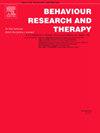以正念治疗疼痛(AMP):一项综合接受和承诺疗法和正念冥想计划的随机对照试验
IF 4.5
2区 心理学
Q1 PSYCHOLOGY, CLINICAL
引用次数: 0
摘要
接受与承诺疗法(ACT)是一种经验支持的治疗慢性疼痛的心理疗法。虽然正念是ACT的关键组成部分,但大多数ACT协议并不包括正式的正念冥想练习作为主要治疗方法,这就留下了正式练习是否会增强ACT效果的问题。为了解决这一问题,本研究评估了正念治疗疼痛(AMP)的可行性和初步治疗效果,AMP是一种基于act的方案,强调并测量日常正式的正念冥想练习。87名退伍军人(Mage = 49.44, SD = 12.42)随机接受AMP或认知行为治疗(CBT)。可行性得到了入学目标的实现、治疗后保留率大于80%、治疗可信度和满意度的高水平的支持。两组的治疗预期均低于假设。在AMP组中,治疗后疼痛干扰(主要结局d = - 0.58)、疼痛接受(d = 0.72)、认知融合(d = 0.23)和疼痛灾难化(d = - 0.50)均有显著改善。在CBT组中,治疗后疼痛干扰(d = - 0.59)、疼痛接受(d = 0.50)和疼痛灾难化(d = - 0.39)均有显著改善。在三个月的随访中,两组的效应量都有所减少。在AMP组中,家庭冥想练习与抑郁症状和疼痛相关无助的更大减少呈剂量依赖关系。综上所述,尽管满足了重要的可行性指标,但该试点随机对照试验的效应量估计强调了在进行正式疗效评估之前进一步开发治疗方法的必要性。本文章由计算机程序翻译,如有差异,请以英文原文为准。
ACTing with Mindfulness for Pain (AMP): A pilot randomized controlled trial of an integrated acceptance and commitment therapy and mindfulness meditation program
Acceptance and commitment therapy (ACT) is an empirically-supported psychotherapy for chronic pain. Although mindfulness is a key component of ACT, most ACT protocols do not include formal mindfulness meditation practice as a principal treatment method, leaving open the question of whether formal practice may bolster ACT's effects. Addressing this gap, the present study assessed the feasibility and preliminary treatment effects of ACTing with Mindfulness for Pain (AMP), an ACT-based protocol that emphasizes and measures daily formal mindfulness meditation practice. A total of 87 Veterans (Mage = 49.44, SD = 12.42) were randomized to AMP or cognitive behavioral therapy (CBT). Feasibility was supported by attainment of enrollment targets, achievement of retention rates at post-treatment greater than 80 %, and high levels of treatment credibility and satisfaction. Treatment expectancy was lower than hypothesized in both groups. Within the AMP group, there were significant improvements in pain interference (primary outcome; d = −0.58), pain acceptance (d = 0.72), cognitive defusion (d = 0.23) and pain catastrophizing (d = −0.50) at posttreatment. Within the CBT group, there were significant improvements in pain interference (d = −0.59), pain acceptance (d = 0.50), and pain catastrophizing (d = −0.39) at posttreatment. In both groups, effect sizes were reduced at 3-month follow-up. Home meditation practice was dose-dependently associated with a greater reduction of depressive symptoms and pain-related helplessness in the AMP group. Taken together, despite meeting important feasibility metrics, the effect size estimates from this pilot randomized controlled trial highlight the need for further treatment development before moving to formal efficacy evaluation.
求助全文
通过发布文献求助,成功后即可免费获取论文全文。
去求助
来源期刊

Behaviour Research and Therapy
PSYCHOLOGY, CLINICAL-
CiteScore
7.50
自引率
7.30%
发文量
148
期刊介绍:
The major focus of Behaviour Research and Therapy is an experimental psychopathology approach to understanding emotional and behavioral disorders and their prevention and treatment, using cognitive, behavioral, and psychophysiological (including neural) methods and models. This includes laboratory-based experimental studies with healthy, at risk and subclinical individuals that inform clinical application as well as studies with clinically severe samples. The following types of submissions are encouraged: theoretical reviews of mechanisms that contribute to psychopathology and that offer new treatment targets; tests of novel, mechanistically focused psychological interventions, especially ones that include theory-driven or experimentally-derived predictors, moderators and mediators; and innovations in dissemination and implementation of evidence-based practices into clinical practice in psychology and associated fields, especially those that target underlying mechanisms or focus on novel approaches to treatment delivery. In addition to traditional psychological disorders, the scope of the journal includes behavioural medicine (e.g., chronic pain). The journal will not consider manuscripts dealing primarily with measurement, psychometric analyses, and personality assessment.
 求助内容:
求助内容: 应助结果提醒方式:
应助结果提醒方式:


